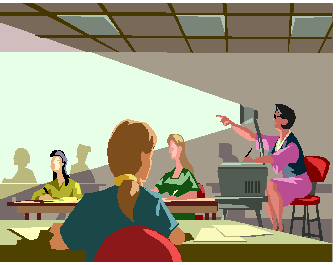|
| |
|
 |
 |
|
Abstract (Nancy) |
|
Exploring how Teachers and Administrators
Make Sense of Tension |
|
In recent years, the education
system has undergone significant reform. Pressures in the form of funding
cuts, legislative changes, and restructuring initiatives have dominated
attention and activities within Ontario schools (PC Educational Reforms,
2003). These pressures trigger tensions related to several aspects of school
functioning, including school restructuring, teacher development, and
improvement in student learning (Imants et al., 2001). Initial response to
reform has focused primarily upon the organizational structures of schools
(Louis, Marks, & Kruse, 1996) rather than on what occurs within those
structures (Elmore et al., 1996). Changing organizational structure is
important, however it is not synonymous with changing beliefs, assumptions,
or behavioural patterns. While there has been some attention given to social
relations among teachers and administrators, and the ways that those
relations affect teaching performance (Smylie & Hart, 1999), there is
limited theoretical study of tension and other aspects of performance. The
purpose of this study is to explore how individual teachers and
administrators have encountered, interpreted, made sense of, and constructed
tension into performance. The research will be conducted in one Ontario
elementary school and will progress in three stages: (a) cultural-historical
analysis of the particular school context, (b) grounded theory investigation
of individual teachers’ and administrators’ experiences of tension within
the school, and (c) participant observation of the collective interaction
between teachers and administrators at school staff meetings.
This research study serves to
contribute to both professional practice and scholarship in organizational
theory and educational administration. The findings of this study may lead
school districts to gain a deeper understanding of teacher and
administrative experiences of tension to inform a process of teacher
development that more closely meets their needs during times of
organizational stress. The research may also be instructive to those who
occupy leadership roles within local schools and school districts, as it
will strengthen our understanding of the internal tensions and
contradictions characterizing individual and social levels change within the
school system. |
|
| |
|
Abstract (Lorraine) |
On-line Education for
Ontario Nurses: A Critical Look at Critical Thinking
|
|
Over the last ten years,
nursing in Ontario has been dramatically affected by computer and
Internet-based technologies. This is demonstrated in several ways including
the use of the computer for patient charting and data entry as well as for
education. Given the recent proliferation of on-line nursing education
strategies dedicated to assisting Ontario’s registered nurses in their
pursuit of meeting the 2005 baccalaureate entrance-to-practice requirement
and increasing use of on-line modules and courses to ensure that nurses are
meeting their continuing professional development needs, I have chosen to
investigate the following question: How does on-line instruction
facilitate the development of the critical thinking skills that registered
nurses require in their practice? For the purposes of this project,
critical thinking will be defined as an experience of reflection through
which the practitioner identifies, confronts, and resolves contradictions
between theoretical and actual practice, thereby achieving more effective
work (Johns, 1995, p. 230).
In my proposed study, the
following will be regarded as possible indicators of critical thinking
within the learning setting: interaction of the student with his or her
learning colleagues and with the instructor (Anderson, 2002);
discipline-specific writing activities (Colomb,1988; Elbow, 1991; Freedman,
1993); and learning and assessment activities that are “multi-logical” in
nature (Morrison & Free, 2001). The California Critical Thinking Disposition
Inventory (CCTDI) will be used to assess nurse-learners for seven identified
dispositions toward critical thinking.
The proposed methodology
involves a mixed methods approach. A two-part survey will be administered to
Ontario nurses who have taken one or more on-line modules/courses in the
twelve month period before the survey or who are enrolled in an on-line
learning module/course at the time of the survey. In Part 1 of the survey,
the nurses will be asked about interaction and discipline-specific writing
in their on-line experiences and about learning and assessment activities.
In Part 2, nurses will complete the California Critical Thinking Disposition
Inventory (CCTDI). To gather additional data and because content delivery
and interaction in on-line courses tends to be text-based, the project will
also include examination
of the on-line writing of a small group of nurse-learners for evidence of
critical thinking. These writings will be studied and analyzed according to
Johns’ (1995) Model of Structural Reflection based on Carper’s (1978)
well-known model of nursing education. |
|
In
addition to the above, the project may also explore the following questions:
 |
What
technical and human supports are offered to nurse-learners to minimize
frustration with technology and maximize critical thinking? |
 |
Have
these supports been tailored to respect possible gender-related learning
needs of this predominantly female group? |
 |
What
writing supports are offered to enhance nurse-learners’
discipline-specific writing skills? |
 |
How
important is an instructor in the fostering of critical thinking?
|
|
|
References |
|
Anderson, T. (2002). An updated and theoretical rationale for interaction.
Unpublished, with permission of the author.
Carper, B. (1978).
Fundamental ways of knowing in nursing. Advances in Nursing Science,1(1),
13-23.
Colomb, G. (1988). Disciplinary
‘Secrets’ and the apprentice writer: The lessons for critical thinking.
Institute for critical thinking: Upper Monclair, New Jersey.
Elbow, P. (1991). Reflections
on academic discourse: How it relates to freshmen and colleagues, College
English, 53(2), 35-155.
Freedman, A. (1993). Show and
tell? The role of explicit teaching in the learning of new genres,
Research in the Teaching of English 27(3), 222-251.
Johns, C. (1995). Framing
learning though reflection within Carper’s fundamental ways of knowing in
nursing. Advanced Nursing Practice, 22, 226-234.
Morrison, S. & Free, K.
(2001). Writing multiple-choice test items that promote and measure critical
thinking, Journal of Nursing Education, 40, 17-26. |
|
|